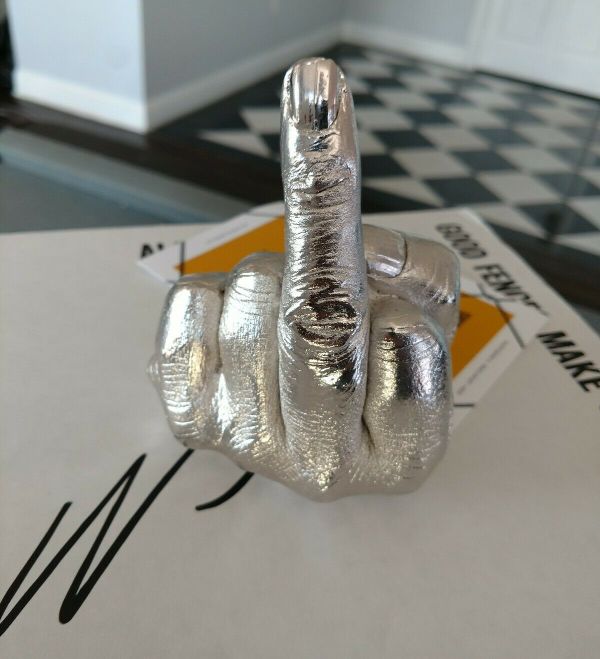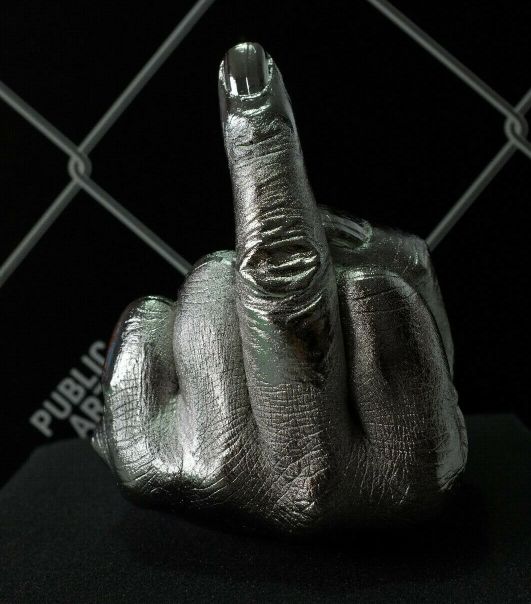Ai Wei Wei (b.1957) is a contemporary Chinese artist whose interdisciplinary practice is rooted in activism. His work addresses issues surrounding sociopolitical systems in China.
The son of poet Ai Qing (1910-1996), Ai Wei Wei was sent with the rest of his family to a labor camp in Heilongjiang and was later exiled in Xinjiang in Northeastern China until the end of the Cultural Revolution in 1976. After returning to Beijing, Ai enrolled in the Beijing Film Academy where he studied animation from 1978 to 1981.
While a student in Beijing, Ai was a key member of Stars, a short-lived, avant-garde collective of politically active, emerging artists practicing in Beijing between 1979 and 1983. On September 27,1979, Stars staged their first exhibition-cum-protest on the fences outside the China Art Gallery (now the National Art Museum of China), after being denied official space in a national exhibition. Although initially shut down by government officials, the artists were permitted to reopen the show later that year in Beihai Park, Beijing. Backlash to the more open policies of the late-70s pressured Stars to disband in 1983. Many of its core members including Huang Rui, Li Shuang, Ma Desheng, Wang Kepin, and Ai Wei Wei went on to gain substantial recognition abroad.
Ai lived in the United States from 1981 to 1993, studying briefly at the University of California, Berkley and University of Pennsylvania before putting down roots in New York City and continuing his studies at the Parsons School of Design. His “New York Photographs” series consists of tens of thousands of photographs documenting his life as a Chinese expatriate in the East Village. During his years in New York he also became increasingly interested in the legacies of Conceptual and Pop art, and befriended Beat poet Allen Ginsberg (1926-1997).
Shortly after his return to China in 1993, he began developing iterative conceptual practice, which takes a critical approach to issues surrounding human rights and freedom of speech. His early works, Coca Cola Vase (1994) and Dropping a Han-Dynasty Urn (1995), interrogate Chinese cultural legacy and the inextricable link between destruction and creation. Coca Cola Vase is a readymade Han Dynasty (206 BCE-220 CE) urn painted with Coca Cola logo, while Dropping a Han-Dynasty Urn (1995) is a document of a performance in three sequential gelatin silver prints, where Ai drops the aforementioned vase. He has also constructed a sculptural version of these photographs made from legos, Dropping a Han-Dynasty Urn (2015).
Ai’s “Study of Perspective” series gives the middle-finger to iconic symbols of cultural or political power. The series began with a photograph, Study of Perspective, Tiananmen Square (1995), at the site of the 1989 massacre of student protesters and has included versions in front of the Mona Lisa, the White House in Washington D.C., the Reichstag in Berlin, and the Trump Tower in New York. He adapted this series to enable more widespread critique with editions of silver and glass casts, titled The Artist’s Hand (2017).
In 2003, Ai founded the Architecture firm FAKE Design, realizing a number of public and private projects in collaboration with Herzog & de Meuron, most notably the “Bird’s Nest” stadium for the 2008 Beijing Olympics. From 2005, Ai’s social media presence, especially his blog on Sina Weibo and Twitter account @aiww, became central to his artistic activism. His body of work surrounding the 2008 Sichuan Earthquake began online in response to a lack of government transparency around the disaster. His Sichuan Earthquake Names Project (2009), for example, was a compilation of the names of student casualties online. He continued to raise awareness about the government’s concealment of the death toll and lax building regulations with Remembering (2009), an installation of nine thousand children’s backpacks, and videos Little Girls Cheeks (2008) and 4851 (2009). Ai was beaten by police while trying to conduct earthquake-related investigations, and Chinese officials eventually responded by shutting down Ai’s blog. Ai continues to revisit the earthquake and similar themes related to human rights and displaced communities in installations and video.
In 2010, Ai was placed under house arrest for ostensible missteps in the construction of a new architecture-focused studio in Shanghai. His house arrest and subsequent surprise demolition of the studio are considered to be politically motivated retaliation for his outspoken criticism of the Chinese government. In 2011, Ai was arrested while boarding a flight to Hong Kong, imprisoned and interrogated for 81 days, and eventually charged for tax evasion. However, Chinese authorities retained his passport, restricting his travel within and outside China until 2015. The artist now lives and works in Cambridge, England.
Ai’s work has been exhibited at venues around the world, most recently at the Mildred Lane Kemper Art Museum, St. Louis (2019), Museo Universitario Arte Contemporáneo, Mexico City (2019), Israel Museum, Jerusalem (2017), the National Gallery, Prague (2017), the Sakıp Sabancı Museum in Istanbul (2017), Hirshhorn Museum and Sculpture Garden, Washington D.C. (2012), Asia Society, New York (2011), the Taipei Fine Arts Museum (2011), and the Tate Modern in London (2010). His work has also been shown with the Public Art Fund, New York City (2017), Venice Biennale (2013), Venice Architecture Biennale (2010), the So Paulo Biennial (2010), and Documenta, Kassel, Germany (2007). He is the recipient of numerous awards including Americans for the Arts’s Marina Kellen French Outstanding Contributions to the Arts Award (2018), Amnesty International’s Ambassador of Conscience Award (2015), the inaugural Václav Havel Prize for Creative Dissent (2012), and the Chinese Contemporary Art Award for Lifetime Achievement (2008).







 Japan
Japan








